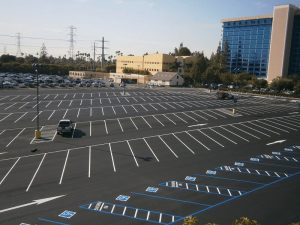
History of Parking Lot Striping in America
Painted lines to mark the center of roadways are believed to have first appeared in Michigan around 1911. Allegedly, an official with the Wayne County Board of Roads observed a milk wagon that was leaving a trail of white behind it due to a leak. The first painted dividing line was on a stretch of Trenton’s River Road. By 1917, white lines were appearing throughout the state of Michigan, including a center line along Marquette County’s notorious “dead man’s curve.”
During 1917, Oregon and California implemented official programs for pavement markings similar to what Michigan had undertaken. However, funding for these projects was limited, and some counties and cities refused to invest in pavement markings. A few private citizens financed markings on particularly treacherous stretches of pavement. For example, the sheriff of Multnomah County, Oregon, paid for the paint to mark a stretch of the Columbia River Highway. In Indio, California, Dr. June McCarroll painted a line on a stretch of what is now U.S. Route 99 after a truck forced her car into a ditch.
Standardization of Pavement Markings
In the early days of pavement markings, every state, town or county could specify the color of paint to be used as well as whether to use solid or broken lines. This led to a great deal of confusion for drivers venturing outside of their immediate area. A broken yellow line in one state, for example, might signify that passing was allowed, but in a neighboring state, the marking might indicate that passing was prohibited.
In 1971, the Federal Highway Administration released new guidelines that were eventually adopted by all states. Yellow was chosen as the color for markings that divided opposing traffic, and white was chosen for markings appearing in lanes traveling in the same direction. Either color can be used for striping parking lots. Blue paint normally signifies handicapped spaces, and red generally denotes a no-parking area.
Pavement Paints
Although reflective buttons and mechanical devices are sometimes used as lane markers, painted pavement markings are by far the most common. Due to environmental concerns, pavement paints containing solvents such as naphtha or toluene have been banned in some jurisdictions. Most pavement markings today use either water-based paint or thermoplastics.
Water-based pavement paints are ideal for temporary markings or areas that receive very little traffic. These markings seldom last longer than four years, and if subjected to high volumes of traffic, they may wear out in less than two years..
Thermoplastic markings can last as long as six or seven years in warm climates. However, they can be damaged by snowplows, resulting in a shorter lifespan. Thermoplastic markings typically have superior reflective properties than water-based paints, but adding reflective beads to paints can reduce the discrepancy.
To Learn More About Pavement Markings
Asphalt Pavement Solutions has been providing our services to customers throughout New Jersey, Pennsylvania and Delaware since 1983. We offer a wide range of services, provide exemplary work and charge reasonable rates. Whether you need parking lot striping and pavement markings for a parking lot or a city street, we can help. We also offer sealcoating, asphalt repair and paving services. For a free estimate, submit the online form or call (856) 461-1710 or (800) 559-SEAL.
See similar posts related to parking lot striping below-


